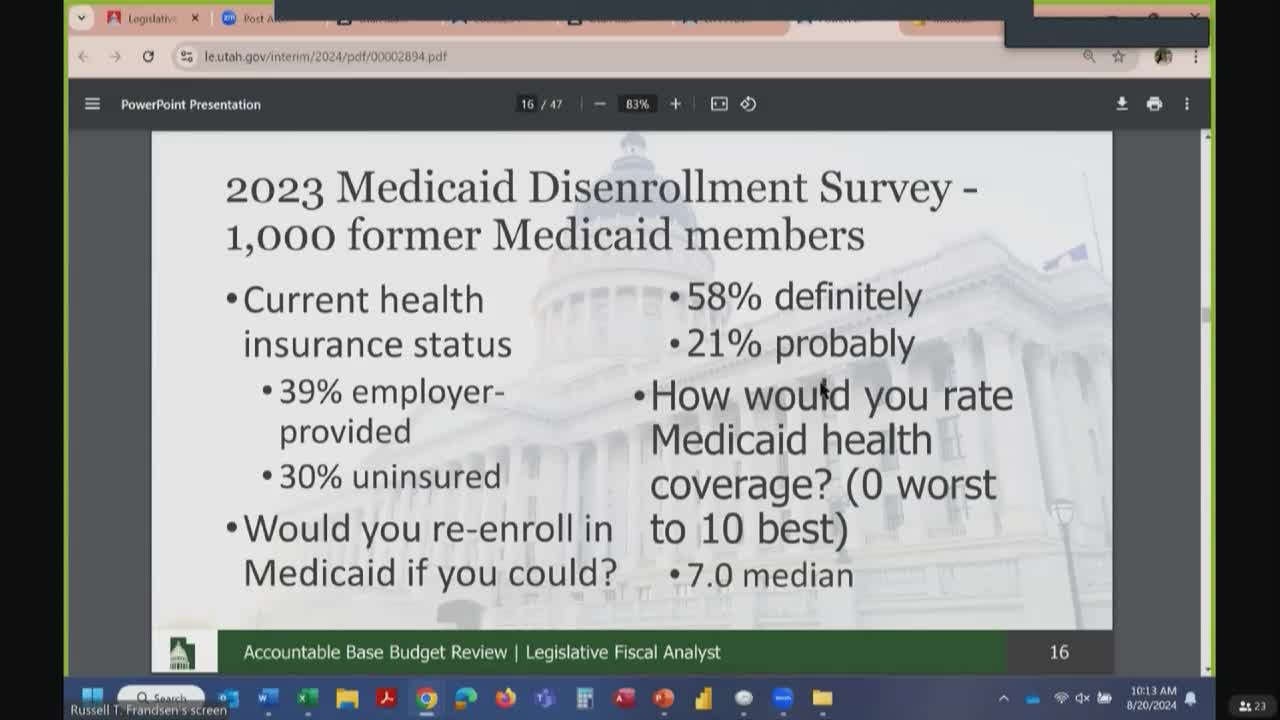Medicaid survey reveals urgent need for reform
August 20, 2024 | Utah Interim, Utah Legislative Branch, Utah
This article was created by AI summarizing key points discussed. AI makes mistakes, so for full details and context, please refer to the video of the full meeting. Please report any errors so we can fix them. Report an error »

A recent government meeting highlighted significant findings from a Medicaid disenrollment survey and discussions on the status of Medicaid waivers aimed at supporting aging clients. The survey, which gathered feedback from former Medicaid members, revealed that 39% of respondents are now covered by employer-provided insurance, while 30% remain uninsured. Notably, 58% expressed a strong desire to re-enroll in Medicaid if given the opportunity, with a median satisfaction rating of seven out of ten regarding their previous Medicaid healthcare coverage.
The survey also identified key areas for improvement, with 23% of respondents citing eligibility income requirements as a major concern, and 13% pointing to difficulties with the renewal application process. Additionally, perceptions of the renewal process varied, with 27% finding it somewhat difficult and 22% rating it as very difficult.
In a separate presentation, the status of Medicaid waivers designed to keep clients out of nursing homes was discussed. The aging waiver, which serves a declining number of clients—from 557 in FY 19 to 480 in FY 23—has shown that only a small percentage of clients transition to nursing homes, indicating the effectiveness of the waiver in providing community-based support. However, concerns were raised about the decreasing number of providers willing to accept state funding for services, which could jeopardize the availability of care.
The meeting also covered the Children's Health Insurance Program (CHIP), which provides coverage for children with incomes above Medicaid thresholds. The program has faced challenges, including a decrease in provider compliance and a drop in the number of eligible children enrolled. The discussion underscored the importance of addressing these issues to ensure that families can access necessary healthcare services.
Overall, the meeting underscored the ongoing challenges within Medicaid and CHIP, particularly regarding provider availability and the need for improved enrollment processes to better serve vulnerable populations.
The survey also identified key areas for improvement, with 23% of respondents citing eligibility income requirements as a major concern, and 13% pointing to difficulties with the renewal application process. Additionally, perceptions of the renewal process varied, with 27% finding it somewhat difficult and 22% rating it as very difficult.
In a separate presentation, the status of Medicaid waivers designed to keep clients out of nursing homes was discussed. The aging waiver, which serves a declining number of clients—from 557 in FY 19 to 480 in FY 23—has shown that only a small percentage of clients transition to nursing homes, indicating the effectiveness of the waiver in providing community-based support. However, concerns were raised about the decreasing number of providers willing to accept state funding for services, which could jeopardize the availability of care.
The meeting also covered the Children's Health Insurance Program (CHIP), which provides coverage for children with incomes above Medicaid thresholds. The program has faced challenges, including a decrease in provider compliance and a drop in the number of eligible children enrolled. The discussion underscored the importance of addressing these issues to ensure that families can access necessary healthcare services.
Overall, the meeting underscored the ongoing challenges within Medicaid and CHIP, particularly regarding provider availability and the need for improved enrollment processes to better serve vulnerable populations.
View full meeting
This article is based on a recent meeting—watch the full video and explore the complete transcript for deeper insights into the discussion.
View full meeting

